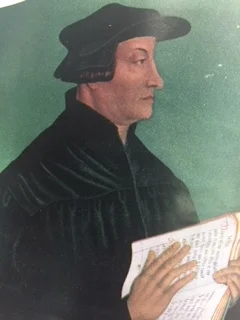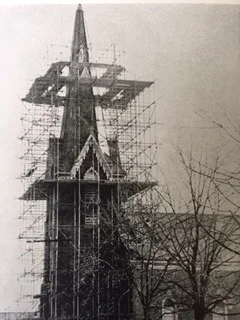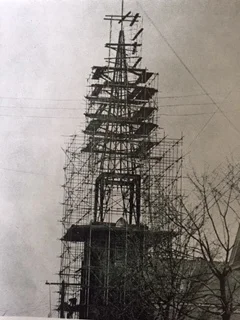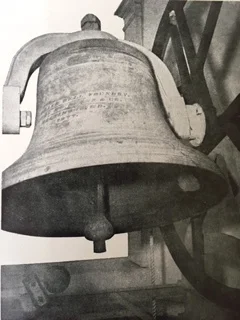European Roots (Shared by Pastor Bruce in worship on january 14, 2018)
As you have probably heard by now, Trinity UCC is celebrating 200 years of service here in the Waynesboro area. In the last week or so, I found out that 1818 must have been quite a year in this area. Not only are we celebrating 200 years, but I found out that the Evangelical Lutheran Church is 200-years-old, as well as, the town of Waynesboro itself!
Throughout this year, during our Sunday worship services, we hope to look back at Trinity’s legacy and celebrate our religious heritage and Christian development by looking at portions of our history that may surprise you.
So, this morning we are starting with the question, “Did you know…that Trinity was started mostly by German immigrants coming to this country from the Palatinate area of the old German Empire?”
Martin Luther
In the early 1700’s, many German people followed Martin Luther, and separated from the Roman Catholic Church, and created the Lutheran Church in Germany. There were other reformers at the time as well that worked to begin the Reformed church such as, Ulrich Zwingli. And yes, I agree, neither of them look very happy. But the desire for religious freedom led to many German migrations first to Holland and later to this country.
Ulrich Zwigli
The guarantee of freedom to worship as they pleased brought many religious sects to Pennsylvania. Why PA? Well, mostly because this was the best advertised colony, and William Penn was the most enthusiastic promoter for the land that held golden promises for these new religious seekers. Penn even went to the point of visiting Germany to extend a personal invitation to come to Pennsylvania.
The first German immigrants came to the ports of New York and Philadelphia. From there, they scattered over a wide territory, northward up the Hudson River, westward toward Reading and into Lancaster and York counties, then southward into Maryland and across Virginia’s Shenandoah Valley. It was from these early migrations that the foundation of the Reformed Church in the U.S. was laid and from which our for bearers came.
These immigrants were people of energy, initiative, and enterprise. No matter their social and economic backgrounds. Otherwise, they would not have undertaken the hazardous ocean crossing, and could not have cleared a continent following their arrival in this new world. They possessed many admirable qualities – they were strong-willed, hardworking, and devoted to their beliefs. They also had some not so admirable qualities – such as their stubbornness. And as we move through this anniversary year, I’m sure you will see a little of all of these qualities…some things will make you proud, some will make you just shake your head!
But for most all of these individuals, religion and faith was not a Sunday ceremony, but the basis and inspirational foundation for daily living.
Bourns Meeting House (presented by garrett austin, as john bourns, in worship on February 11, 2018)
Good morning to all of you fine folks here this morning! My name is John Bourns and if you can’t tell, I came to this fine country all the way from Scotland way back in 1751. At the time, I was just a wee lad of four-years-old. My family moved and settled in Lancaster County because of the promise of religious freedom.
Eventually in, or around 1773, my wife Esther and I crossed the South Mountain by way of Mentzer Gap Road and arrived in Wallacetown, which is what Waynesboro was called back in those days. I had a lot of plans for myself and my family, and I picked out a beautiful spot right beside the Antietam Creek near what is known as Roadside. There I built our house. I also built a blacksmith shop and sawmill, and I used the water from the creek to provide myself with the power I needed to run the mill. I got very good at making sickles, which many of you modern day folks might not know what they were used for…but the farmers knew what they were and used them to cut up their grain crops. My business really grew, mainly because I worked really hard at everything I did and the people here grew to respect me.
Me and my wife ended up having 11 children…yeah, I know, that’s a lot of kids! But we wanted them to go to school and many of our neighbors had the same hope for their kids. So, I ended up building a cabin on a hill just on the eastern edge of town as a meeting house where church could be held on the Sabbath and children could be taught during the week.
Photo 1.
Here’s what it looked like back then (Photo 1). Oh, I know, it’s nowhere near as grand as your building here! And you can see in this picture (Photo 2) there wasn’t a whole lot of room to move about!
Photo 2.
I built it with logs I sawed in my sawmill, and I hammered out the door hinges and all the fasteners and nails in my blacksmith shop. It was my gift to the people of Waynesboro! Children came from up to six miles away to attend school at my schoolhouse.
But in the spirit of religious tolerance and cooperation, which is the reason my family came to this wonderful country in the first place, all kinds of religious denominations used the cabin as a place of worship on Sundays. There were worshippers that were Presbyterian, Lutheran, Methodist, Covenanter (which was my church) and your forbearers as well… the Reformed.
Photo 3.
Here’s what it looks like today (Photo 3).
Well, I really appreciate you inviting me here this morning to share a little of my history and my involvement in Waynesboro. I hope, as you continue through your year of celebrating 200 years of ministry here in this fine town, that your celebrations continue to be joyous. Thank you!
“Houses” of Worship (shared by Pastor bruce during worship on April 29, 2018)
Did you know that when our German Reformed ancestors first settled in this area, they worshiped at the Evangelical Reformed Church of Irishtown, just south of Zullinger, which is the current Salem Church in Washington Township?
Salem Church.
There weren’t many churches back in those days. Sometime around 1773, which is when Salem Church was formed, there weren’t many ministers to serve churches. Because of the fact that travel was difficult and slow, members of the Salem Church came to feel the need for a congregation nearer their home in Waynesboro, so they withdrew from the Salem congregation to organize a new church. This is why the Salem congregation is known as "Trinity’s Mother Church," since we were formed out of, and with the support of, their members.
Christ Union Church.
In 1807, the Reformed church, along with the Lutherans and the Presbyterians, started to build a house of worship together. It was on Mechanics Street, which is the current Church Street, and it is where the Waynesboro Church of the Brethren is located. The church was completed in 1818 and dedicated as Christ Union Church. The Reformed congregation had its first communion service on November 15, 1818, and had a total membership of 83.
Salem's German Evangelical Reformed Church.
In 1826 the Reformed people decided to build their own house of worship, mainly because they wanted to keep German as their language in worship and exclude English. So, they built a small log house of worship where we currently are located, which was consecrated on May 20, 1827. It was known as Salem’s German Evangelical Reformed Church in Waynesboro. Conrad Dotter, one of the members, donated the land on which the building was built, and we’ll hear more about Mr. Dotter and some of his antics in a later “Did You Know.”
Are you counting how many buildings our congregation worshiped in so far? We’re not done yet! In the year 1833, a new church building was started, this one made out of brick, and it was completed in June of 1834. As the church continued to grow, there was need for a larger building. So, in 1871, at a cost of $20,000, another building was constructed which is the foundation of, and for the most part, aside from various renovations and additions, our current building.
In the 200 year history of Trinity, there were actually four buildings, (five, if you include Salem), that our ancestors worshiped in at various times. In the next few months, we’ll be talking more about these historical details of our history including talking about our steeple. In fact, a little challenge and friendly competition - a prize will go to the person(s) who come up with the correct answer to how tall our steeple is, and how big the cross is at the top of the steeple. Members of the 200th anniversary committee are not eligible for prizes and are not allowed to give out the answers!
The Church Steeple and Bell – (Shared by Pastor Bruce Druckenmiller during worship on June 10, 2018)
During last month’s “Did You Know?” moment, I challenged the congregation to guess the height of our church steeple and the cross at the top of the steeple. I didn’t see any guesses on the sign-up board, so, I’m assuming you don’t want to know. But as churches were built to provide places for worship, church towers with high steeples became focal points to indicate locations for local and distant travelers. When Trinity’s first brick church was built, it contained a tower with an even taller spire.
Photo 1.
In Photo 1, you can see the tower being dismantled. It’s lofty presence with vertical lines enhanced the appearance of the church, directing viewers eyes upward toward the heavens. Because the steeple was one of the highest architectural features in the town, it provided a landmark for people to find the church from any part of town. It told all who saw it, that a religious presence was standing watch in the community.
Photo 2.
















